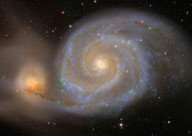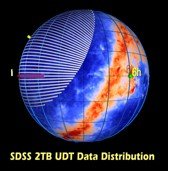Sloan Digital Sky Survey (SDSS) Data Transfers

Website
http://www.sdss.org/Contact
Alex Szalay, John Hopkins University, United StatesRobert Grossman, University of Illinois at Chicago
Collaborators
Australia: University of MelbourneChina: National Astronomical Observatories, Chinese Academy of Sciences
Germany: Max-Planck-Institut für Plasmaphysik
Japan: Institute for Cosmic Ray Research, University of Tokyo
The Netherlands: SARA; University of Amsterdam
South Korea: Korea Astronomy and Space Science Institute, KISTI
United States: John Hopkins University; National Center for Data Mining, University of Illinois at Chicago; University of California, San Diego; NASA Goddard Space Flight Center
Description
The Sloan Digital Sky Survey (SDSS) is a two-phase astronomical survey—the most ambitious ever undertaken—and uses a dedicated, 2.5 metre telescope on Apache Point, New Mexico, equipped with two powerful special purpose instruments: a 120-megapixel camera for imaging the sky, and a pair of spectrographs fed by optical fibers to measure spectra of galaxies and quasars.

SDSS-1, completed in June 2005, imaged one quarter of the sky in five band passes (8000 sq-degrees at 0.4 arc sec accuracy). It detected nearly 200 million celestial objects and measured the spectra of over 675,000 galaxies, 90,000 quasars and 185,000 stars. SDSS-II is underway until 2008, and will carry out three distinct surveys to address fundamental questions about the nature of the universe, the origin of galaxies and quasars, and the formation and evolution of the Milky Way.
Currently, SDSS datasets are transferred from a cluster at the StarLight Facility in Chicago to scientists around the world using the UDT transport protocol developed by the National Center for Data Mining at the University of Illinois at Chicago and the Sector peer-to-peer storage system, which uses UDT and is designed for easily distributing large e-science datasets. Sector and UDT won the SC'06 Bandwidth Challenge by transporting the 1.3 Terabyte SDSS BESTDR5 catalog data set from Chicago to Tampa over a 10 Gbps wavelength at a sustained rate of over 8 Gbps and a peak rate of 9.18 Gbps.

